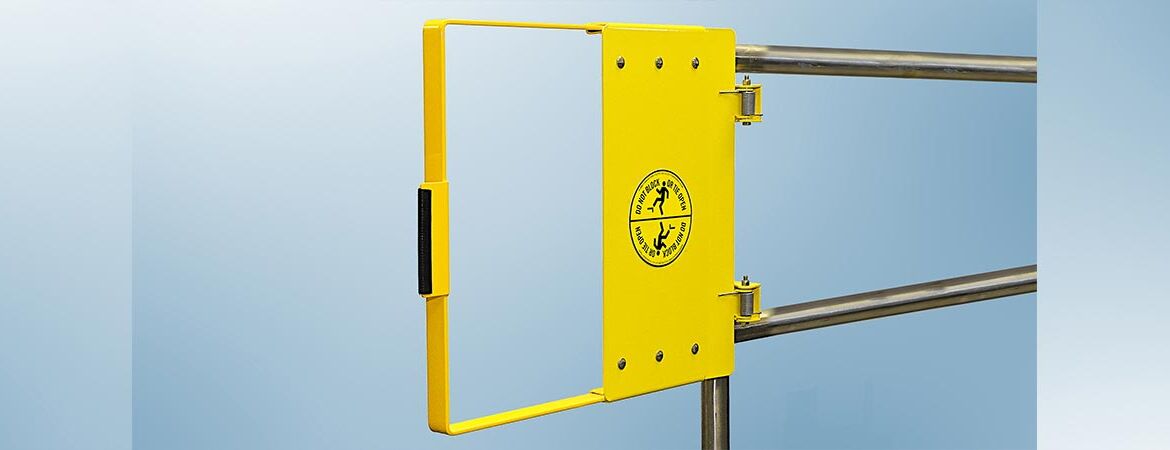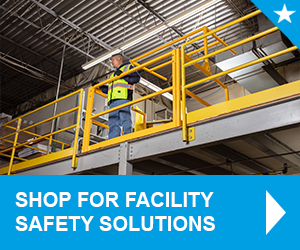
Safety gates are dependable options for maintaining secure, easy access to stairways and ladders, fixed heavy machinery, walking working platforms and more. Workers in industrial settings must frequently navigate narrow stairways, ladder access points and potentially dangerous equipment that can’t be left openly accessible. With an industrial self closing safety gate, you can fulfill a wide range of functional and compliance needs when fall risks and accessibility issues would otherwise present competing needs.
When is a Gate the Right Solution?
To enter potentially hazardous job sites, workers need to move through areas safely and easily. Warehouses, distribution centers, flat roofs, and other work settings must comply with OSHA or local regulatory standards for fall protection and other safety protocols.
In some cases, such as the top openings of ladders, safety gates are required – see OSHA 1910.28(b)(3)(iv). In other instances, a fall protection gate fulfills general fall protection requirements much more effectively than the other options. For instance, OSHA’s ladder regulations (1910.23) allows the use of safety gates instead of chains and other non-rigid members or handrails for mobile ladder stands and platforms higher than 4 feet (1.2 m).
It’s important to always consult your local regulations, along with OSHA and CCOHS, when making safety-related decisions. In most cases where accessibility and fall protection needs collide, an industrial self closing safety gate is not only an acceptable option, but also a much safer and effective one.
Consider the other two alternatives in the example above:
- Non-rigid members, such as chains. While chains are better than most other non-rigid members, they leave mostly open space. It’s far from a comprehensive form of fall protection.
- Handrails. For much firmer support from falling bodies and objects, handrails are clearly a more secure solution. Of course, they lack the flexibility of non-rigid members.
It’s a common predicament safety managers face, where a seemingly more efficient option comes with a dramatic loss in a device’s most important function: safety.
Maximizing Protection & Flexibility with Handrail Gates
When competing needs arise, the best solution will eliminate the conflict entirely. That’s exactly what a fall protection gate does, where a rigid passive fall barrier no longer serves as an impediment to easy movement. You could say a safety gate combines the best aspects of railing and chains.
Thus, it’s important that self closing handrail gates be:
- Aligned with the top of surrounding handrails
- Built to the same force-resistance standards as code-compliant railings
- Easy to open, with smooth latching mechanisms
Self closing handrail gates from the most innovative fall protection manufacturers fulfill all these needs and more. When equipped with self-closing mechanisms, safety gates simplify workflows, especially for repetitive tasks. In addition, more user-friendly safety equipment contributes to greater safety.
How Self Closing Safety Gates Prevents Risk
By supporting staff with the user-friendly and adaptable fall protection gate solutions, they can perform their work smoothly and efficiently, secure from the dangers they’d otherwise be exposed to. The most innovative fall protection manufacturers fulfill all these needs with self closing handrail gates that provide access to areas guardrails would otherwise block.
There are numerous benefits of an industrial self closing safety gate. Compared with the alternative, it is a classic example of when surpassing safety standards can have a tremendous impact on site efficiency and reduced liability.
These gates:
- Allow workers approaching stairways or ladders to focus on assessing the area – not the gate.
- Provide workers a safe opportunity to stop and rest. During summer rooftop work, for example, a safety gate/railing enclosure can help staff’s eyes adjust before entering the roof and catch their breath before entering indoors.
- Ensure the gate is firmly latched after every use, rather than remain open and risk losing its fall-arrest function or knocking into people or objects. For example, a mobile ladder stand with a standard swing gate could come ajar if not latched properly, presenting risk of falling objects or property damage.
- Keep workers’ hands free, instead of forcing them to adjust their grip and risk dropping objects to handle the gate. When standard gate latches wear out, they can easily malfunction. Self closing mechanisms from leading fall protection manufacturers require no latch at all.
Selecting an Industrial Self Closing Safety Gate
First, fully analyze your use case. Considering mounting location, space requirements and any environmental factors, such as outdoor or indoor use. Unique applications often require specialized gates with several material options, including:
- Stainless steel
- Carbon steel
- Aluminum
- Safety yellow powder coat or enamel (preferably an eco-friendly variety)
- Other color or finishing options (e.g., for color code systems)
They may also require comparing a range of safety gate types and features, ranging from vertical lift gates that preserve floor space to different mounting mechanisms and ground clearances. Full coverage safety gates, for example, provide top-to-bottom coverage that exceeds that of guardrails.
In addition, any modern fall protection gate you choose should be built to the following design standards:
- All-weather build, including corrosion-resistant zinc-plated mounting hardware
- Designed for easy signage and safety label mounting
- Secure clamp-on mount, for near-universal application
- Easy-installation using basic hardware and simple hand tools
Self closing gates for construction, where falls are the number one workplace injury, require the greatest adaptability. Their universal mounting adaptors install in minutes with only simple hand tools, making it easy to reposition as operational needs change.
Some designs do not even require handrail post contact (at the opening side), providing a full positive stop with an optional stop plate on the outside hinges. The same type of gate is commonly used on elevated platforms.
A versatile safety gate should come in a wide variety of opening widths, meeting a tight tolerance window. For specific gate openings, depend on an experienced custom-fabrication specialist. You can also close the gap with a receiver plate, which has the added benefit of bolstering stopping power.
Mounting adaptors give more advanced models greater adaptability in a range of mounting locations, most commonly:
- Tubular steel
- Square/flat railing
- Angle bar
- Existing walls
Lastly, there’s no reason not to expect the same safety gate to provide left or right mounting. After all, your need for versatility should begin at the installation.
Keeping Worksite Equally Safe and Accessible with Self-Closing Gates
Self closing handrail gates, while not always necessary, are almost always a better option to fulfill both compliance standards and workplace efficiency. Fabenco is proud to supply the most advanced safety gates on the market for industries as broad as manufacturing, energy, food processing, transportation, higher education, and much more.
Contact us with any questions about our extensive range of specialized and universal safety gate options. We can help you determine the right industrial self closing safety gate for your operations, often with nothing more than the interior gate opening.





